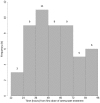Reduced susceptibility of Plasmodium falciparum to artesunate in southern Myanmar
- PMID: 23520478
- PMCID: PMC3592920
- DOI: 10.1371/journal.pone.0057689
Reduced susceptibility of Plasmodium falciparum to artesunate in southern Myanmar
Abstract
Background: Plasmodium falciparum resistance to artemisinins, the first line treatment for malaria worldwide, has been reported in western Cambodia. Resistance is characterized by significantly delayed clearance of parasites following artemisinin treatment. Artemisinin resistance has not previously been reported in Myanmar, which has the highest falciparum malaria burden among Southeast Asian countries.
Methods: A non-randomized, single-arm, open-label clinical trial of artesunate monotherapy (4 mg/kg daily for seven days) was conducted in adults with acute blood-smear positive P. falciparum malaria in Kawthaung, southern Myanmar. Parasite density was measured every 12 hours until two consecutive negative smears were obtained. Participants were followed weekly at the study clinic for three additional weeks. Co-primary endpoints included parasite clearance time (the time required for complete clearance of initial parasitemia), parasite clearance half-life (the time required for parasitemia to decrease by 50% based on the linear portion of the parasite clearance slope), and detectable parasitemia 72 hours after commencement of artesunate treatment. Drug pharmacokinetics were measured to rule out delayed clearance due to suboptimal drug levels.
Results: The median (range) parasite clearance half-life and time were 4.8 (2.1-9.7) and 60 (24-96) hours, respectively. The frequency distributions of parasite clearance half-life and time were bimodal, with very slow parasite clearance characteristic of the slowest-clearing Cambodian parasites (half-life longer than 6.2 hours) in approximately 1/3 of infections. Fourteen of 52 participants (26.9%) had a measurable parasitemia 72 hours after initiating artesunate treatment. Parasite clearance was not associated with drug pharmacokinetics.
Conclusions: A subset of P. falciparum infections in southern Myanmar displayed markedly delayed clearance following artemisinin treatment, suggesting either emergence of artemisinin resistance in southern Myanmar or spread to this location from its site of origin in western Cambodia. Resistance containment efforts are underway in Myanmar.
Trial registration: Australian New Zealand Clinical Trials Registry ACTRN12610000896077.
Conflict of interest statement
Figures







References
-
- Noedl H, Se Y, Schaecher K, Smith BL, Socheat D, et al. (2008) Evidence of artemisinin-resistant malaria in western Cambodia. N Engl J Med 359: 2619–2620. - PubMed
-
- World Health Organization (2011) Global plan for artemisinin resistance containment (GPARC). Available: http://www.who.int/malaria/publications/atoz/artemisinin_resistance_cont.... Accessed 22 Janurary 2012.
-
- Delacollette C, D’Souza C, Christophel E, Thimasarn K, Abdur R, et al. (2009) Malaria trends and challenges in the Greater Mekong Subregion. Southeast Asian J Trop Med Public Health 40: 674–691. - PubMed
Publication types
MeSH terms
Substances
Grants and funding
LinkOut - more resources
Full Text Sources
Other Literature Sources
Medical

